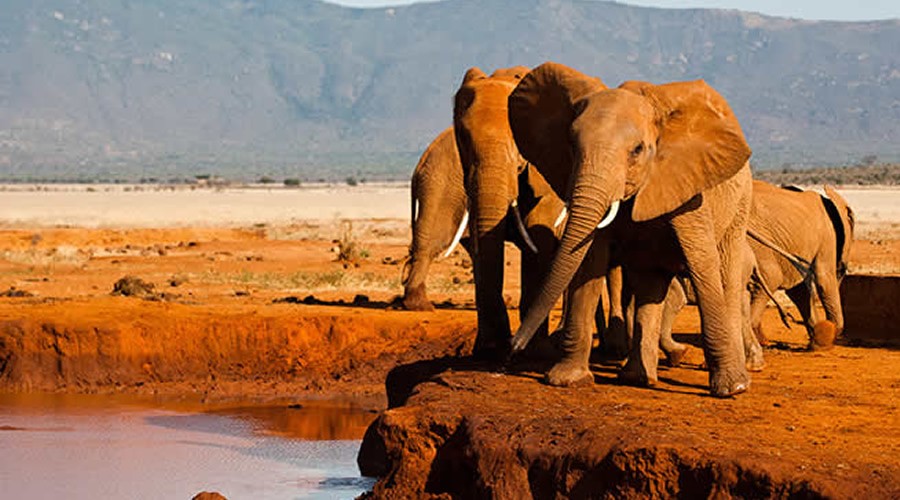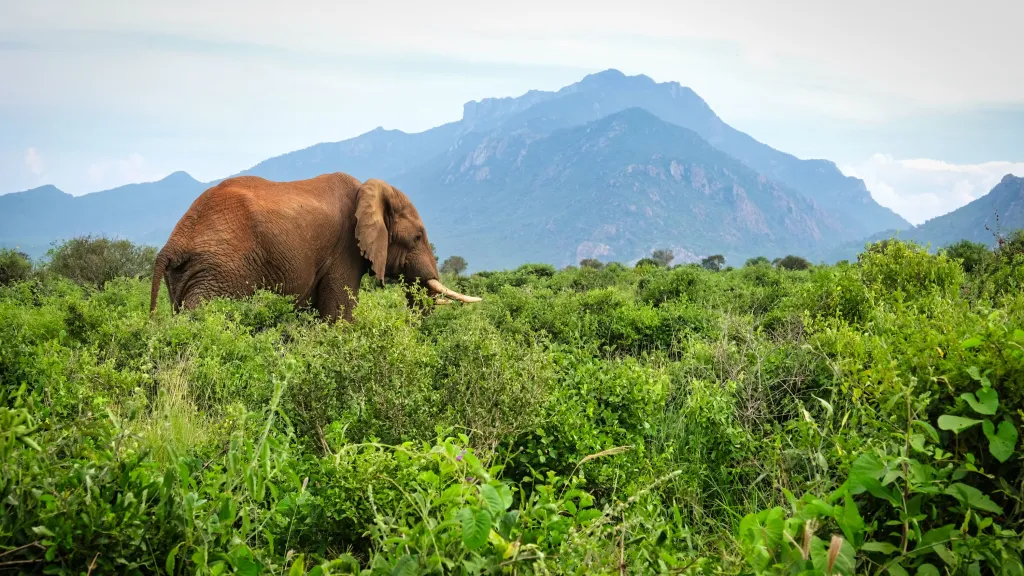Tsavo National Park, known for its vast wilderness, is a haven for Africa’s incredible wildlife. At the heart of this ecosystem lies the ‘Giants of Tsavo’ – the magnificent elephants. In this exploration, we dive into their intriguing world, the rich history of Tsavo, and the safari adventures that await every explorer.
The Legacy of the Tsavo Man-Eaters
The Legacy of the Tsavo Man-Eaters: In the heart of Tsavo National Park, the story of the Tsavo man-eaters unfolds, a tale as captivating as it is chilling. During the construction of the Uganda Railway at the end of the 19th century, two colossal lions stalked the night, halting progress and terrifying workers. These predators, who seemingly developed a taste for human flesh, dragged men from their tents, causing panic and halting construction. The lions’ relentless assaults not only impacted the lives of those who were there but also captured the global imagination. This dark period played a significant role in Tsavo’s history, highlighting the unpredictable and untamed nature of the wild.
The construction of the railway across Tsavo was a monumental undertaking, aimed at connecting Uganda to the Indian Ocean. However, the unforeseen challenge posed by the Tsavo man-eaters brought a new dimension of terror to colonial expansion in Africa. The story of these lions is not merely about the threat they posed but also about the human response to their reign of terror. It was John Henry Patterson, a British military engineer, who eventually brought an end to their tyranny, but the legacy of the Tsavo man-eaters lived on.
The saga of the man-eaters drew attention to Tsavo, affecting perceptions of the African wilderness and its creatures. It underscored the imposing presence of wildlife in this part of the world, where humans are merely visitors. This event also marked a turning point, leading to a greater emphasis on wildlife conservation and the creation of protected areas. Tsavo transitioned from a region fraught with peril to a sanctuary for wildlife, safeguarding the unique ecosystems and majestic creatures that call it home. The archaeological findings in the area further enrich the park’s narrative, providing insights into ancient civilizations and the natural history that predates human involvement.
Through the transformation into a protected reserve, Tsavo has become a pivotal location for conservation, research, and eco-tourism. The park now stands as a testament to the balance between human progress and the need to preserve our natural heritage. The man-eaters of Tsavo remind us of the wild’s unpredictable nature and the intrinsic value of preserving such untouched landscapes for future generations to marvel at and learn from.
The Giants of Tsavo
Following the intriguing history of the Tsavo Man-Eaters, we delve deeper into the enchanting world of Tsavo, specifically focusing on the majestic elephants that call the Tsavo National Park their home—the true giants of Tsavo. These magnificent creatures are not only a symbol of Africa’s untouched wilderness but also a testament to the resilience of nature in the face of adversity.
The elephants of Tsavo are distinctive, often characterized by their reddish color, a result of dust-bathing in the park’s rich iron oxide soil, which acts as a natural sunscreen and parasite deterrent. This unique adaptation is a vivid reminder of the harsh and beautiful landscape they inhabit. Delving into their behaviors reveals complex social structures, intricate communication methods, and highly intelligent problem-solving capabilities. Matriarchs lead family units, guiding them through vast migratory patterns that follow the seasonal rains, ensuring their survival in the unpredictable arid environment.
However, the journey of Tsavo’s giants is fraught with challenges. Human activities, including poaching and habitat encroachment, pose significant threats to their existence. The latter part of the twentieth century saw devastating losses among Tsavo’s elephant population due to ivory poaching. It was a stark reminder of the vulnerability of these majestic animals and the urgent need for conservation efforts.
In response to these challenges, a multitude of conservation initiatives has been put in place to protect Tsavo’s elephants. These efforts range from anti-poaching patrols and ivory stockpile management to community-based conservation projects that foster human-elephant coexistence. The involvement of local communities in conservation efforts has proven particularly effective, transforming former poachers into passionate protectors of wildlife. Additionally, research and monitoring initiatives have provided valuable insights into elephant behavior and migratory patterns, informing conservation strategies and ensuring the protection of critical habitats.
The significance of Tsavo’s elephants extends beyond their awe-inspiring presence; they play a crucial role in the ecosystem, shaping the landscape through their feeding and migratory habits, and dispersing seeds that ensure the regeneration of the flora. Their survival is intertwined with the health of the entire ecosystem. Conservation efforts in Tsavo showcase the possibility of reversing the damage caused by human activities, offering hope for elephants and other wildlife across Africa.
As visitors embark on Amboseli National Park and Masai Mara National Park tours, the importance of these efforts becomes glaringly apparent. Observing Tsavo’s elephants in their natural habitat, guided by knowledgeable guides, offers an unfiltered glimpse into the lives of these giants, showcasing their beauty and the challenges they face. It’s a poignant reminder of the fragile balance between humans and nature and the vital importance of coexistence and protection for the future of Tsavo’s wildlife. The narrative of Tsavo’s elephants is an integral part of Africa’s conservation story, demonstrating the resilience of nature and the power of concerted conservation efforts.
Safari Adventures in Tsavo
Building on the understanding of the majestic elephants of Tsavo National Park and their conservation, we delve into the unique safari experiences this park offers. Tsavo, divided into Tsavo East and Tsavo West, presents diverse safari adventures, ranging from guided tours, self-drive escapades to immersive walking safaris. Each offers a distinct way to experience the park’s untamed beauty.
Guided tours are tailored to maximize wildlife sightings, led by experienced guides familiar with the elephants’ patterns and the park’s geography. These safaris are ideal for those looking to learn about the ecosystem and its inhabitants. Meanwhile, self-drive adventures offer a more personal encounter with Tsavo, allowing visitors to explore at their own pace. Navigation through the vast expanses of the park, following dusty tracks under the vast African sky, can be both challenging and exhilarating. For the intrepid explorer, walking safaris represent the pinnacle of adventure. Accompanied by armed guides, these treks allow visitors to experience the African bush up close, tracking elephants and other wildlife on foot.
The dry season, spanning from June to October, is the best time to visit for wildlife viewing. During this period, animals congregate around water sources, making them easier to spot. The panorama of red dust-covered elephants, a hallmark of Tsavo, against the backdrop of the rugged wilderness, is an iconic sight. Beyond elephants, visitors may also encounter lions, leopards, and the diverse birdlife that calls the park home.
The following chapter will extend the exploration into Tsavo’s ecological richness and biodiversity, highlighting the symbiotic relationships and the global ecological significance of this unique habitat.
Ecological Richness and Biodiversity
Following a captivating journey through the safari experiences in Tsavo National Park, where guided tours, self-drive adventures, and walking safaris unravel the mysteries of nature, the narrative deepens into the ecological richness and biodiversity of Tsavo East and West. The vivid semi-arid grasslands stretch beneath the expansive African sky, revealing a landscape that is both stark and teeming with life. Here, the Yatta Plateau, the world’s longest lava flow, stands as a natural monument, overseeing the park’s diverse ecosystem. The nurturing Galana River carves through the park, providing a vital lifeline that supports an impressive array of fauna and flora.
The diversity of species found within these contrasting ecosystems is staggering. Beyond the iconic elephants, which paint themselves in red dust, Tsavo teems with lions, whose manes blend into the savannah, and the elusive black rhinos that tread quietly behind the scenes. But it’s not just the famed inhabitants that draw naturalists and conservationists; it’s also home to a complex web of lesser-known flora and fauna that contribute to the park’s ecological significance.
Symbiotic relationships abound in this semi-arid landscape, demonstrating the interconnectedness of life. The baobab trees, for example, rely on elephants to break open their hard seed pods, aiding in their propagation, while providing the giants with a nourishing meal. This intricate exchange underlines the importance of each species in maintaining the ecosystem’s balance.
The biodiversity of Tsavo serves as a critical habitat for migratory bird species, adding another layer to its global ecological significance. It becomes a haven, not just for resident wildlife but also for avian visitors seeking refuge along their journey.
The ecological richness of Tsavo East and West is a testament to the delicate balance of life and the urgent need for conservation efforts. As this chapter weaves into the following discussion on conservation challenges and successes, it highlights the pivotal role of this region not just in preserving its own biodiversity, but in sustaining ecological health at a global scale.
Conservation Challenges and Successes
Following the exploration of the Tsavo National Park‘s rich ecological tapestry, we delve into the complexities of conservation within this vast landscape, exploring both the challenges faced and the innovative measures taken to ensure the survival of its giants. The specter of poaching looms large, driven by a global demand for ivory despite international efforts to curb the trade. This illicit activity not only threatens the elephant population but also destabilizes the park’s ecological equilibrium, disrupting symbiotic relationships between species as detailed in the preceding discussion on Tsavo’s biodiversity.
Human-wildlife conflict further complicates conservation efforts. As the human population encroaches on previously wild areas, incidents of crop raiding by elephants and other wildlife lead to a retaliatory hunt, underscoring the need for strategies that foster coexistence.
Climate change introduces another layer of uncertainty, altering rainfall patterns and water availability in Tsavo, thereby impacting the delicate balance of its ecosystems. Prolonged droughts stress the park’s water resources, testing the resilience of its inhabitants and the savannah they roam.
In response, concerted efforts by non-governmental organizations, the Kenyan government, and local communities have seen the implementation of successful conservation strategies aimed at safeguarding Tsavo’s future. Anti-poaching units and advanced technology, including aerial surveillance drones, have been deployed to combat illegal hunting effectively. Community-based conservation initiatives have been pivotal, integrating sustainable development with wildlife protection to ensure local communities benefit from preserving their natural heritage.
Moreover, initiatives aimed at mitigating human-wildlife conflict, such as the construction of chili fences and the use of beehive fences, are examples of innovative and sustainable strategies that protect crops and deter elephants, providing a dual benefit of crop protection for farmers and honey for local markets.
Looking ahead, the emphasis on community involvement and education appears paramount. Strengthening the bond between Tsavo’s wildlife and those who live at its borders ensures a shared sense of responsibility for its protection. Future initiatives must continue to balance ecological integrity with the needs of local communities, fostering an environment where both wildlife and human populations can thrive. The ongoing challenge will be to adapt and evolve these conservation strategies in the face of the dynamic threats posed by poaching, human-wildlife conflict, and climate change, ensuring the preservation of Tsavo’s majestic elephants and the diverse ecosystem they inhabit.
Conclusions
Tsavo National Park represents a unique convergence of history, wildlife, and conservation efforts. From the legendary man-eaters to today’s majestic elephants, Tsavo’s stories captivate and inspire. The park’s diverse landscapes and ecosystems are critical to Africa’s natural heritage. By supporting conservation practices and sustainable tourism, we ensure this iconic refuge continues to enchant future generations.




